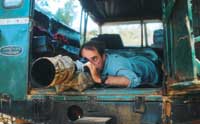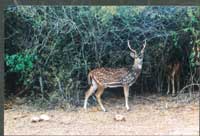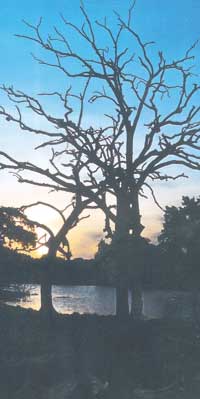| Plus |
|
|||
Hooked to the wilds Veteran
wildlife photographer Andy Rouse is here to shoot leopards and elephants
to bring them to the focus of the world Andy Rouse, 38, is in Yala to bring the Sri Lankan leopard into the spotlight worldwide.Andy based in Britain has been commissioned by publisher Evans Mitchell Books to work on two books covering elephants and leopards, due to be published in the spring and summer of 2004. These will form a series of six books. Having covered much of the African leopard, Andy claims that over the years there has been a great deal of focus on African leopards. "But both the Asian leopard and elephant deserve prominence. I want to highlight the Lankan leopard which is one of eight sub-species in the world.” In Yala, his first day turns out to be lucky. For, Andy had "leopard sightings". The early morn safari at 5 took him to a water hole where he managed to catch two cubs in action. He ventured out again in the evening eager to get more shots of the one-year-old cubs and The Sunday Times accompanied him to see him in action. We circled the same area where he had spotted the cubs in the morning - looking and listening, aided by a Sri Lankan team. Something unusual in the landscape, anything that moves, bird calls, the movement of other animals, were the clues. It was a long evening and there were no signs of any feline beauties. But Andy did not seem disappointed. "It's only my first day and on this job you learn to just sit and wait. Sometimes they never come out and you dismiss it because it doesn't really matter." Just as everyone was getting ready to call it a day, there they were enjoying a lazy moment. Twenty minutes of non-stop clicking and a night of editing did not seem to satisfy Andy and the Lankan team comprising Marlon Saldin, team manager, Ifham Raji, who was instrumental in getting Andy to Sri Lanka and Dr. Ravi Samarasinha better known as the "leopard boss" didn't seem the least surprised. He goes for
the best. It's just his professionalism, they say as a way of explanation. Explaining that his book is "two-dimensional" he says, "At one level, the primary goal is to capture the subject, at another level, through the book, to give publicity to the places where one can see these animals.The countries I visit will benefit from it." On tourism, he says, while it's important for national parks to have visitors, there is also a need for policy to effectively manage this kind of development. "The problem is that national parks get spoiled when people try to change them - all wildlife need is water. This place has such great potential and yet with it comes the potential to ruin it." His greatest concern for Yala is the proposed dam project that he feels will damage the eco-system. "The key to the park is the water and this project which proposes to dam the Menik River to create a reservoir for development schemes means that water holes will dry out. I've seen this happen around the world, I don't want to see it here. There aren't many places where you can take a drive to go see a leopard. For me, it's a 10-hour flight away." Award-winning photographer Andy has his own TV series, conducts seminars, writes columns and gives his photographs for conservation efforts. He has been a professional photographer for eight years now. How did he get there? The day he gave up working as a computer consultant. "The job was too stressful, came with too much responsibility and I didn't quite like the person I was." He then decided it was time to do something different, something he loved - wildlife photography. "It's a passion, you love what you do and you can't switch off because it makes you." He admits with a laugh that it sounds like a "line" but that's just it - he's hooked. |
||||
Copyright © 2001 Wijeya Newspapers
Ltd. All rights reserved. |


